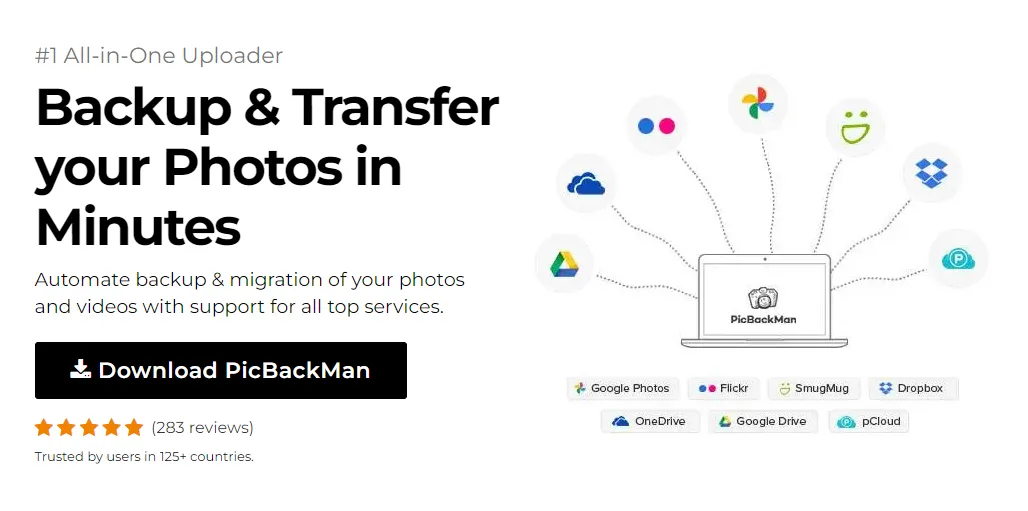
Why is it the #1 bulk uploader?
- Insanely fast!
- Maintains folder structure.
- 100% automated upload.
- Supports RAW files.
- Privacy default.
How can you get started?
Download PicBackMan and start free, then upgrade to annual or lifetime plan as per your needs. Join 100,000+ users who trust PicBackMan for keeping their precious memories safe in multiple online accounts.
“Your pictures are scattered. PicBackMan helps you bring order to your digital memories.”
5 Easy Ways to Backup Google Drive to iCloud


Keeping your digital files safe is essential in today's world. If you use both Google Drive and iCloud, you might wonder how to create a backup system between these two popular cloud services. Having your Google Drive files backed up to iCloud provides an extra layer of security and peace of mind.
In this guide, I'll walk you through 5 straightforward methods to backup your Google Drive files to iCloud. These approaches work for both beginners and tech-savvy users, so don't worry if you're not particularly comfortable with technology.
Why Backup Google Drive to iCloud?
Before diving into the methods, let's quickly look at why you might want to backup Google Drive to iCloud:
- Extra security against data loss
- Access to files even if one service experiences downtime
- Simplified file management across Apple and Google ecosystems
- Protection against account lockouts or security breaches
- Peace of mind knowing your important documents are in multiple locations
Method 1: Manual Download and Upload
The simplest way to backup Google Drive to iCloud is through manual transfer. While it requires more hands-on work, it gives you complete control over which files get backed up.
Step-by-Step Process:
- Download files from Google Drive : Log in to your Google Drive account and select the files you want to backup.
- Create a local folder : Make a temporary folder on your computer to store the downloaded files.
- Download the files : Right-click on the selected files and choose “Download.” Wait for the download to complete.
- Access iCloud Drive : Open iCloud Drive on your computer or go to iCloud.com and sign in.
- Upload to iCloud : Drag and drop the downloaded files from your local folder into iCloud Drive.
- Verify the transfer : Check that all files have been successfully uploaded to iCloud.
Pros of Manual Transfer:
- No third-party tools required
- Complete control over which files get backed up
- One-time process for files that don't change often
- No ongoing subscription costs
Cons of Manual Transfer:
- Time-consuming for large amounts of data
- Not practical for regular backups
- Requires you to remember to perform backups
- No automation or scheduling options
Method 2: Using the Desktop Apps
Both Google Drive and iCloud offer desktop applications that sync files to your computer. By setting up both apps, you can create an automatic backup system through your local machine.
Step-by-Step Process:
- Install Google Drive for Desktop : Download and install the Google Drive for Desktop app from Google's website.
- Set up Google Drive sync : Configure the app to sync all or selected folders to your computer.
- Install iCloud for Windows/Mac : Download and install the iCloud desktop application for your operating system.
- Configure iCloud Drive : Set up iCloud Drive to sync with your computer.
- Create a Google Drive backup folder : In your iCloud Drive folder on your computer, create a new folder called “Google Drive Backup” or something similar.
- Copy or move files : Manually copy the files from your Google Drive folder to the backup folder in iCloud Drive.
- Optional automation : Use your computer's built-in tools like Task Scheduler (Windows) or Automator (Mac) to automate the copying process on a schedule.
Pros of Desktop App Method:
- Works with existing official apps
- Can be partially automated
- No need to manually download and upload files
- Works offline once set up
Cons of Desktop App Method:
- Requires sufficient storage space on your computer
- Both services must be running on the same machine
- May slow down your computer when syncing large files
- Full automation requires additional setup
Method 3: Using Third-Party Backup Services
Several third-party services can help you sync or backup data between cloud storage providers. These tools are designed specifically for cloud-to-cloud transfers and backups.
Popular Cloud-to-Cloud Backup Services:
1. MultCloud
MultCloud is a web-based service that allows you to manage and transfer files across cloud storage services.
Steps to use MultCloud:
- Create a MultCloud account at multcloud.com
- Add both your Google Drive and iCloud accounts to MultCloud
- Use the "Cloud Transfer" feature to move files from Google Drive to iCloud
- Set up scheduled transfers for regular backups
2. Rclone
Rclone is a command-line program to manage files on cloud storage. It's more technical but very powerful.
Basic Rclone setup:
- Install Rclone on your computer
- Configure Rclone to connect to both Google Drive and iCloud
- Use commands to sync or copy files between services
- Set up cron jobs (Linux/Mac) or scheduled tasks (Windows) for automation
3. CloudHQ
CloudHQ offers cloud backup and sync services between multiple cloud platforms.
Using CloudHQ:
- Sign up for a CloudHQ account
- Connect your Google Drive and iCloud accounts
- Create a sync pair between Google Drive and iCloud
- Choose sync options (one-way or two-way)
- Start the sync process
Pros of Third-Party Services:
- Designed specifically for cloud-to-cloud transfers
- Automated scheduling options
- No need to download files to your local device
- Can handle large amounts of data efficiently
- Often include additional features such as file filtering
Cons of Third-Party Services:
- May require paid subscriptions for full functionality
- Privacy concerns with giving access to your cloud accounts
- Dependent on the third-party service's reliability
- May have limitations on file sizes or transfer speeds
Method 4: Using IFTTT (If This Then That)
IFTTT is a web service that creates chains of simple conditional statements, called "applets." You can use it to automatically backup specific Google Drive files to iCloud.
Setting Up IFTTT for Google Drive to iCloud Backup:
- Create an IFTTT account : Go to ifttt.com and sign up for an account if you don't already have one.
- Connect services : Connect your Google Drive account to IFTTT.
- Create a new applet : Click on "Create" and then "If This."
- Choose Google Drive as the trigger : Select "New file in folder" or another relevant trigger.
- Set up the trigger details : Specify which Google Drive folder to monitor.
- Choose "Then That" : Unfortunately, IFTTT doesn't directly support iCloud, so you'll need a workaround.
- Use Dropbox or OneDrive as an intermediate : Connect one of these services and set the action to save the file there.
- Final step : Use your computer's iCloud sync to move files from the intermediate cloud service to iCloud.
Pros of IFTTT Method:
- Free for basic usage
- Automated process
- Can be set up for specific folders only
- Works without your computer being on
Cons of IFTTT Method:
- Limited direct support for iCloud
- May require an intermediate cloud service
- Limited to 1,000 applet runs per month on free plan
- Not suitable for large files or large quantities of files
- May experience delays in syncing
Method 5: Using Apple Shortcuts (for iOS/Mac Users)
If you're primarily an Apple user, you can use the Shortcuts app to create automated workflows that download files from Google Drive and save them to iCloud.
Creating an Apple Shortcut for Google Drive to iCloud Backup:
- Open the Shortcuts app on your iPhone, iPad, or Mac.
- Create a new shortcut : Tap the “+” button to create a new shortcut.
- Add the "Get Contents of URL" action : This will be used to access the Google Drive API.
- Add authentication : You'll need to set up OAuth authentication for Google Drive.
- Add actions to process the files : Use “Get File” actions to download the Google Drive files.
- Add "Save File" action : Configure it to save to iCloud Drive.
- Add automation trigger : Set the shortcut to run on a schedule or when certain conditions are met.
- Test and refine : Run the shortcut manually to make sure it works as expected.
Pros of Apple Shortcuts Method:
- Deeply integrated with Apple ecosystem
- No third-party services required
- Can be triggered automatically or manually
- Highly customizable
Cons of Apple Shortcuts Method:
- Only works on Apple devices
- Requires technical knowledge to set up properly
- May have limitations with very large files
- Can be complicated to troubleshoot
Comparison of All 5 Methods
| Method | Ease of Setup | Automation | Cost | Best For |
|---|---|---|---|---|
| Manual Download/Upload | Very Easy | None | Free | One-time backups, few files |
| Desktop Apps | Moderate | Partial | Free | Regular backups, moderate file sizes |
| Third-Party Services | Easy to Moderate | Full | Free to Paid | Large file collections, regular backups |
| IFTTT | Moderate | Full | Free (with limits) | Small, specific file types or folders |
| Apple Shortcuts | Complex | Full | Free | Apple ecosystem users, customized workflows |
Tips for Efficient Google Drive to iCloud Backup
Organizing Your Files Before Backup
Before starting any backup process, it's helpful to organize your Google Drive files:
- Delete unnecessary files to avoid wasting storage and transfer time
- Create a clear folder structure that you can replicate in iCloud
- Prioritize which files need backing up first or most frequently
- Consider compressing large files or folders to save space and transfer time
Managing Storage Space
Both Google Drive and iCloud offer limited free storage, so managing your space is important:
- Check your available storage in both services before starting large transfers
- Consider upgrading your iCloud storage plan if needed
- Remove duplicate files to save space
- Use selective sync to only backup the most important files
Scheduling Regular Backups
For ongoing protection, establish a regular backup schedule:
- Daily backups for frequently changed, critical files
- Weekly backups for moderately important documents
- Monthly backups for archival materials
- Set calendar reminders if using manual methods
Security Considerations
When backing up between cloud services, keep security in mind:
- Use strong, unique passwords for both Google and Apple accounts
- Enable two-factor authentication on both services
- Be cautious with third-party services that request access to your accounts
- Check permissions regularly and revoke access for services you no longer use
- Consider encrypting sensitive files before uploading them
Troubleshooting Common Issues
Files Not Syncing Properly
If you notice files aren't transferring correctly:
- Check your internet connection stability
- Verify file size limits (some methods have restrictions)
- Ensure you have sufficient storage space in iCloud
- Check for special characters in filenames that might cause issues
- Try transferring smaller batches of files
Slow Transfer Speeds
For sluggish transfers between services:
- Use a wired internet connection if possible
- Close other bandwidth-intensive applications
- Try transferring during off-peak hours
- Break large transfers into smaller batches
- Check if your ISP throttles cloud storage traffic
Duplicate Files
If you end up with duplicate files in iCloud:
- Use the "replace" option instead of "keep both" when prompted
- Consider using file comparison tools to identify duplicates
- Set up clear naming conventions for your backup files
- Use date-stamped folders for periodic backups
Authentication Problems
When facing login or authentication issues:
- Re-authorize the applications or services
- Check if you need to approve the connection in security settings
- Update your passwords if it's been a while
- Verify that third-party access hasn't been blocked by new security settings
Quick Tip to ensure your videos never go missing
Videos are precious memories and all of us never want to lose them to hard disk crashes or missing drives. PicBackMan is the easiest and simplest way to keep your videos safely backed up in one or more online accounts.
Simply download PicBackMan (it's free!) , register your account, connect to your online store and tell PicBackMan where your videos are - PicBackMan does the rest, automatically. It bulk uploads all videos and keeps looking for new ones and uploads those too. You don't have to ever touch it.
Conclusion
Backing up your Google Drive files to iCloud doesn't have to be complicated. Whether you prefer the simplicity of manual transfers, the automation of third-party services, or the integration of Apple Shortcuts, there's a method that will work for your needs.
Remember that the best backup strategy often combines multiple approaches. You might use a third-party service for regular backups of all files while setting up Apple Shortcuts for immediate backups of your most critical documents.
By implementing one or more of these backup methods, you'll gain peace of mind knowing your important files are safely stored in both Google Drive and iCloud, protected against accidental deletion, account issues, or service outages.
Frequently Asked Questions
Is it possible to automatically sync between Google Drive and iCloud?
Yes, but not directly through official channels. You'll need to use third-party services like MultCloud or CloudHQ, or set up automation through desktop applications or tools like Apple Shortcuts or IFTTT. These solutions can create automatic syncing between the two cloud services.
How much storage do I need in iCloud to backup Google Drive?
You'll need at least as much free space in iCloud as the total size of the Google Drive files you want to backup. Apple offers 5GB of free iCloud storage, but you can upgrade to larger plans starting at $0.99/month for 50GB. Check your Google Drive storage usage before starting to ensure you purchase enough iCloud space.
Will backing up to iCloud preserve my Google Docs formatting?
Google Docs, Sheets, and Slides files need to be exported to compatible formats (like DOCX, XLSX, or PDF) when backing up to iCloud. This conversion may cause minor formatting changes. For the most accurate preservation, consider exporting to PDF format, which will maintain the visual appearance but won't be as easily editable.
How often should I backup my Google Drive to iCloud?
The frequency depends on how often your files change and their importance. For critical documents that change daily, daily backups are recommended. For less critical files, weekly or monthly backups may be sufficient. If using automated methods, you can set up daily incremental backups that only transfer new or changed files to minimize bandwidth usage.
Can I restore my iCloud backup to Google Drive if needed?
Yes, you can restore files from iCloud to Google Drive using similar methods as described in this article, just in reverse. The manual download/upload method works in both directions, as do most third-party cloud transfer services. This bi-directional capability makes these backup methods valuable for not just backup but also recovery scenarios.






